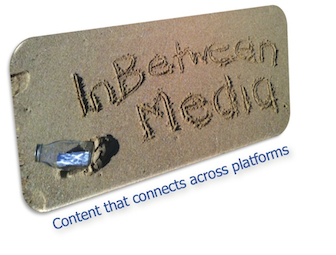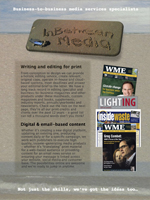 Commenting on the divestments and acquisitions in the B2B media world this year, some have suggested that the bigger players are attempting to move away from print ad-dependent business models. With Reed Business Information selling off some trade magazines in Europe and then acquiring a carbon market analytics firm, its focus appears to be on expanding the reach of data businesses.
Commenting on the divestments and acquisitions in the B2B media world this year, some have suggested that the bigger players are attempting to move away from print ad-dependent business models. With Reed Business Information selling off some trade magazines in Europe and then acquiring a carbon market analytics firm, its focus appears to be on expanding the reach of data businesses.
Investing in areas such as data services and events are not new developments in the B2B media sector, however there are now significant opportunities for publishers to consolidate and evolve relationships with customers in an increasingly fragmented media environment.some trade magazines in Europe and then acquiring a carbon market analytics firm, its focus appears to be on expanding the reach of data businesses.
Professional services firm PricewaterhouseCoopers (PwC) believes more rationalisation of titles is expected, with the lifecycle of magazines shortening. It estimates over the next five years, global B2B media will grow at an annual rate of 2.8% to US$214bn in 2017, up from US$186.7bn in 2012. However Australia, the world’s ninth-largest B2B market, will be overtaken by Brazil in 2014 and by Russia in 2016.
In attempts to achieve the holy trinity of content, community and commerce, B2B publishers are considering ways they can service their customer groups better and generate revenue.
The decision is not as simplistic as whether to print or not to print. There are new print titles being launched and, although not in the B2B arena, News Limited recently decided to take its digital channel taste.com.au into print. This is despite the fact that print advertising revenues are declining for magazines in general, although less profoundly in B2B markets.
ZenithOptimedia forecasts internet advertising will increase 14.4% in 2013, with this growth coming at the expense of print media. Internet advertising is slated to increase its market share from 18% in 2012 to 23.4% in 2015, with newspaper and magazine ad spends shrinking at an average of 1-2% per cent a year. By 2015 ZenithOptimedia predicts online advertising spend will overtake print.
This is in line with PwC’s media outlook to 2017 which projects digital advertising spending to represent a quarter of all advertising by the end of the forecast period.
“Digital investments continue, but only at a pace that converts analogue dollars into digital dimes, perhaps even pennies,” the report states. “Thus, the digital divisions of publishing businesses are akin to living in an unfinished extension that has been built onto a house that fewer people come to visit.”
With only minimal revenue for B2B publishers coming from paid subscriptions, due to most being controlled circulation publications, publisher and media consultant John Blondin said it was essential that companies in this space continued to innovate and develop additional sources of revenue.
“Publishers are realising now that they have databases that can retail product. So publishing doesn’t describe now what some publishers are doing… they are creating retail opportunities especially online as e-tailers,” he said.
Clever use of customer data as a means of developing new business and better advertising models is being held up as a way to stop the revenue leak from traditional publishing models.
“The challenge is there is an awful lot of data out there,” said PwC technology and communications leader David Wiadrowski, nominating social media, mobile or location-based data and transactional data as the key types with which media companies needed to come to terms.
Media and technology consultant Ben Shepherd wrote recently that he believes the challenge is ultimately about re-establishing advertiser confidence in a medium that is still highly supported by consumers.
“The industry also needs much more conviction in the way it deals with the market. The magazine industry of late has generally been meek and mild publicly, struggling for oxygen against digital companies pushing research, insights, new developments and technology down the throats of agencies and advertisers”.
Different ways to tell a story
One factor in the B2B market that is often overlooked is trends amongst marketers. While it appears their reliance on print magazines is declining, they still have an overriding need to generate leads from their activities and increase brand awareness.
But it’s not just readers who are becoming media moguls in their own right, deciding when and how they will consume news. Business people are also doing the same. By gathering information and becoming informed about products and services, it is becoming harder for B2B companies to market using traditional methods. This has resulted in a shift by marketers to relationship building, measurability and digital mediums.
On average, 25% of marketing budgets (B2C and B2B) in Australia are allocated to content marketing and 61% of Australian marketers plan to increase this over the next 12 months.
“Magazines publishing is a somewhat outdated term, we are now talking about engagement through multi-platforms,” said Blondin, noting the trend of marketers to replace outbound methods like magazine advertising with inbound tactics that focus on producing and distributing material that is valuable and interesting to their target audience and monetising it.
“Everybody talks about best practice… I believe it’s next practice. It’s more about innovation online around content, it’s about working with the client and engaging your audience,” he said, adding that only a few B2B publishers are really exploring this.
There’s no doubt storytelling is now more visual, immediate and increasingly marketing centric. Information on marketing trends shows that last year saw a significant upswing in the number of B2B marketers using online video.
With Google and Amazon in the US now placing almost US$2bn in each into advertising, Blondin said, “That gives you an idea of the massive shift into that world but it mightn’t be in anything that’s traditional… we’ve seen stacks of YouTube videos of viral marketing that people remember.
“Therein lies the problem for the smaller publishing group. When you’re small and you haven’t got the financial or human resource to… you just don’t compete so you’ve got to stick to your strengths, play to your strengths”.
Blondin believes the strength of most B2B publishers is in quality content, both current and archival. “With publishers in the B2B space databases are generally an under-valued asset and can be more fully exploited.”
Media companies are in the box seat to provide these services but in order to “feed the beast” they need to learn how to collaborate and let go of self-limiting publishing models.
For example, content selection needn’t be an exclusive process, there are recent successful examples of media companies getting readers involved in editorial agenda setting and interactively producing news. And information production is no longer the exclusive domain of media companies, so collaboration could provide the additional resources that B2B media companies often need.
PwC suggests two of the most critical questions B2B publishers need to ask themselves are how they can differentiate their business, and the products/services they provide and where do they want to operate in the content and digital advertising value-chain?
B2B strategy should be a constant work in progress, said Blondin, adding that five-year strategies are no longer feasible. “You’ve got to be able to change your strategy instantaneously with market trends and direction and that means you have to have a great understanding of where you’re positioned in your market as well as an absolute understanding of the dynamics of your readership.
“We’re not talking about the strength of numbers such as critical mass in the consumer field, we’re talking about the quality of engagement.”
© 2013 InBetween Media


Comments are closed.